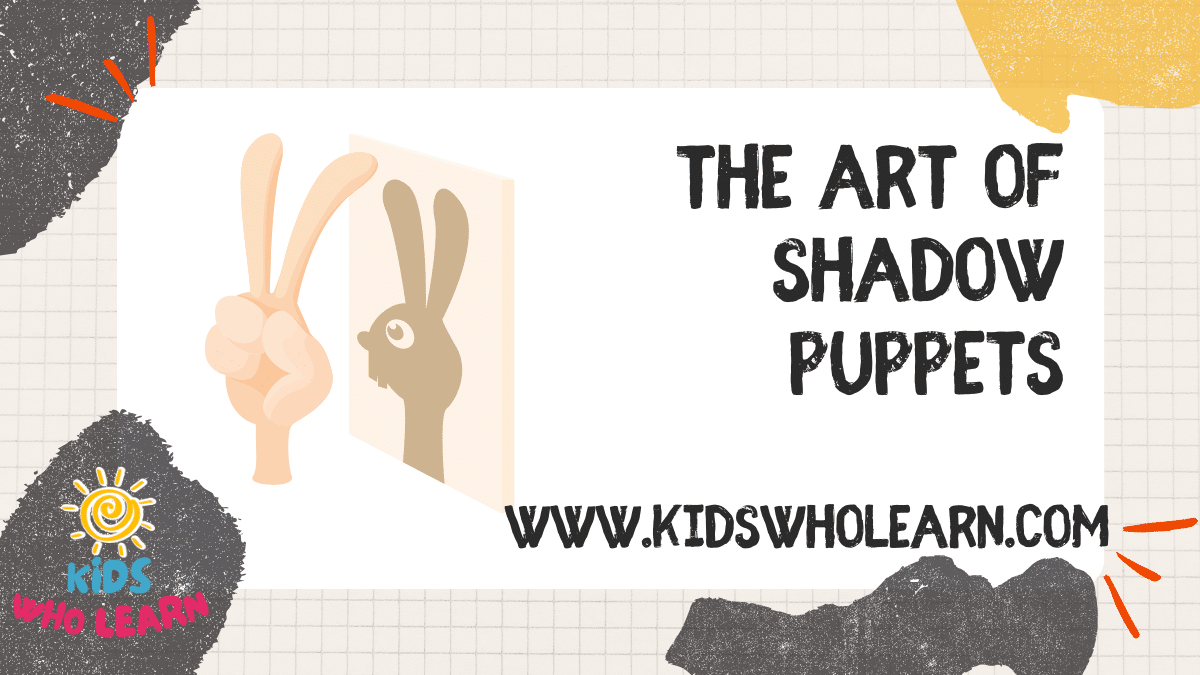Shadow puppets offer a unique blend of storytelling and visual art that ignites the imagination. By manipulating puppets behind a screen illuminated from behind, you can create a captivating play of characters and narratives. This art form not only entertains but also fosters creativity, as you craft figures and scenarios from nothing but shadows.
As you explore the world of shadow puppets, you engage in a playful activity that has both historical significance and educational value. Kids can learn about the science of shadows, the art of puppet-making, and the joy of performance, all within their very own productions. Whether at home or in a classroom setting, shadow puppetry provides a dynamic platform for interaction and learning.
Key Takeaways
- Shadow puppetry combines storytelling with visual art, enhancing creativity.
- Kids learn about science and art through crafting and manipulating puppets.
- Shadow plays offer educational and entertaining experiences for various settings.
Understanding Shadows
Shadows are a fascinating phenomenon that occur when an opaque object obstructs light from a light source, creating a silhouette on a surface. This section will help you explore their scientific basis, how to observe them, and their behavior throughout the day.
The Science of Shadows
Shadows form because light travels in straight lines and, when hindered by an object, it casts a shadow behind that object on a surface. The size and shape of the shadow are determined by the angle of the light source and the distance between the object and the light source. For instance, when the sun is at its highest point in the sky around noon, shadows will be at their shortest due to the decreased angle.
Properties of Shadows:
- Length: Varies with the time of day; longer early and late in the day, and shorter when the sun is overhead.
- Direction: Opposite the light source and dependent on its angle.
- Visibility: Most distinct on a clear, bright day and less visible in dim light.
Observing Shadows
Observation of shadows can be both a fun activity and an educational science experiment. You can see shadows by placing an object under sunlight or artificial light like headlights. Notice how, at sunrise or sunset, your shadow appears elongated, while at noon, it is much shorter. This is because the angle of the light source, whether it’s the sun or artificial light, changes relative to the object.
Shadow Science Experiments:
- Use a sundial: Track the shadow of the gnomon (stick) to tell time.
- Shadow sketching: Trace your shadow on the pavement throughout the day to record changes.
Shadows through the Day
As Earth rotates, the angle at which sunlight hits its surface changes, altering the length and direction of shadows. During sunrise and sunset, shadows are longest because the sun is low on the horizon. At noon, when the sun is directly overhead, your shadow is at its smallest due to the light hitting you at a smaller angle.
Daily Shadow Changes:
- Sunrise: Extended shadows with a soft edge due to the angle the sunlight travels.
- Noon: Minimal shadow length, sharp edges due to the sun’s position.
- Sunset: Similar to sunrise, with long shadows stretching opposite the sun.
By monitoring how shadows change from sunrise to sunset, you gain insight into the science of light and the three-dimensional aspect of the world around you.
Crafting Shadow Puppets
Creating shadow puppets is a hands-on activity that can spark creativity and story-telling. By using simple materials, you can craft intricate puppets to animate your own magical tales.
Materials You’ll Need
| Essential Items | Optional Add-ons |
|---|---|
| Cardstock or cardboard | Markers and pens |
| Craft sticks or straws | Tissue paper |
| Tape or glue | – |
| Scissors | – |
To create a shadow puppet, you will need opaque materials such as cardstock or cardboard. These materials block light, creating a distinct shape or silhouette. You’ll assemble the puppet parts using craft sticks or straws to provide stability and maneuverability. Binding tape or glue is essential to hold your pieces together. Additionally, for more elaborate puppets, translucent tissue paper can give color, while markers and pens add details.
Creating the Puppets
Firstly, decide on the character or object for your puppet, and sketch the shape onto the cardboard. Animal shadow puppets are a popular choice due to their recognizable silhouettes. Once the shape is drawn, use the scissors to carefully cut it out. If needed, multiple shapes can be cut out and pieced together for more complex figures.
Assembling the Puppet Parts
Once your cut-outs are ready, attach a craft stick or lolly stick to the back of each shape at strategic points using tape. This stick will act as the handle and the puppet’s control mechanism. If your puppet consists of several parts, like limbs or wings, join them with tape to allow for movement. Ensuring the parts are securely fastened will save you from mid-performance mishaps.
By following these steps, you can craft unique shadow puppets and bring them to life.
Setting the Stage for Shadow Play
Preparing the stage for shadow play is fundamental in ensuring that the shadows cast are clear and engaging for the viewers. The surface you choose, the lighting setup, and the control of shadow size and clarity are all pivotal points to consider.
Choosing a Surface
Your choice of surface is crucial; it acts as the screen for your shadow play. A flat, white surface such as a piece of cloth, a pull-down screen, or even a blank wall will work best. This type of surface will reflect light more effectively, creating crisp and visible shadows. Use the following checklist for selecting an appropriate surface:
- Ensure the surface is smooth and wrinkle-free.
- Check that the surface color is white or light-colored for maximum contrast.
- The surface should be large enough to accommodate the intended shadow images.
Lighting and Background
The lighting and background are essential for creating effective shadows. You’ll need a single light source that’s bright enough to cast sharp shadows. A flashlight, table lamp, or torch can serve as your light source. Remember, the background needs to be as dark as possible to enhance the sharpness of the shadows cast by your puppets. Here’s how to set up your lighting:
- Position the light source at a suitable distance from the surface to achieve the desired shadow clarity.
- The angle of the light is important; experiment with different positions to avoid distorting the shadows.
Controlling Shadow Size and Clarity
Controlling the shadow size and clarity allows you to bring dynamics and depth into your shadow play. The distance between your puppets and the light source will affect the size of the shadows; moving the puppets closer to the light source makes the shadows larger, while moving them away reduces their size. Shadows become sharper when the object is closer to the surface and the light source is directly behind it. The puppet should be opaque to block the light effectively. Here’s a simple guide to adjust the shadow size and clarity:
- Move the puppets closer to or further from the light source to change the size.
- For clearer shadows, ensure there is no ambient light interfering with the light source.
Bringing Puppets to Life
To truly engage an audience with shadow puppets, you need to master their movements, weave captivating stories, and follow some tried and true performance tips.
Mastering Puppet Movements
Your hands are pivotal in shadow puppetry, as they bring the inanimate shapes to life. Focus on the movements that make your shadow puppet walk or dance with fluid motions, ensuring the silhouette is clear against the backdrop.
- Walking: Synchronize the puppet’s “legs” with slight thumb and finger articulation to mimic a realistic walk cycle.
- Dancing: Move your wrist in harmony with the puppet’s body to produce a graceful dance, perhaps twisting to show a spin.
Experimenting with moving the light source can also create the illusion of your puppet changing size or interacting with other puppets.
Storytelling Techniques
Storytelling in shadow puppetry goes beyond just dialogue; it’s about the visual presentation of your narrative. Your puppets should encapsulate the essence of the characters in your story.
- Character Development: Use distinct gestures to personify each puppet’s personality traits.
- Plot Progression: Implement a variety of speeds and styles of movement to reflect the evolving plotlines.
Integrate interactive elements by having your puppet react to sounds or engage with the audience to keep the story engaging.
Performance Tips
The key to a successful performance lies in preparation and the creative use of the environment.
- Sound: Enhancing your show with sound effects can complement the movement of the puppets and add depth to the performance.
- Video: For more complex performances, consider incorporating prerecorded background video to set the scene.
Remember, your performance’s quality is measured by your ability to maneuver the shadow puppet smoothly and your silhouette’s clarity against the lit background. Challenges in puppetry can be overcome with practice and attention to the subtleties of hand movements.
Educational Activities with Shadow Puppets
Shadow puppets offer an interactive way to engage children in various educational subjects, bridging creativity with scientific and mathematical concepts, while also exploring art and culture.
Science and Shadows
Understanding how shadows are formed is fundamental in science. Your lesson plan can include creating shadow puppets to explore the properties of shadows. By manipulating the distance and angle of the puppet to a light source, kids learn about:
- Size changes based on distance from the light
- Angle variations affecting the shadow’s length and orientation
- Sunlight to discuss how shadows outside change from sunrise to sunset
A hands-on activity could involve recording shadow changes with a video to solidify scientific observations.
Mathematics and Measurement
Shadow puppets can teach math through hands-on activities that involve measurement and geometry. Your tasks might include measuring:
- The length of shadows at different times of the day
- Angles created between the puppet, the light source, and the shadow using a protractor
Creating a table for recording these measurements can assist kids in noticing patterns and improve their ability to predict sizes of shadows based on the time of day.
Art and Storytelling
Creativity flourishes in the art of shadow puppetry. You can encourage kids to:
- Design their shadow puppets with detailed outlines and cutouts
- Create a storyboard for a shadow play, enhancing their narrative skills
This activity combines artistic skills with storytelling, allowing children to express ideas literally through the shadows they cast.
Cultural Lessons
Shadow puppetry has a rich history across various cultures. Your lesson plan could include:
- A brief video introduction to shadow play’s origins and methods around the world
- A hands-on project where students create puppets from different cultures, thus understanding the global nature of this art form
Through this, they’ll gain appreciation for diverse artistic expressions and storytelling traditions.
Fun Facts and Historical Context
Shadow puppetry, with its rich tapestry of historical and cultural significance, offers an engaging avenue for children to explore creativity. This art form has ancient roots, spanning back to China over 2,000 years ago. It’s believed that this entertaining practice was initially created to comfort a grieving emperor by bringing shadows of his beloved to life.
Shadow Puppetry Across Cultures:
- China: Classed among the oldest storytelling techniques, it features figures made from animal hides with articulated limbs.
- Indonesia: Known as ‘Wayang Kulit,’ the puppets are intricately carved and often depict epic Hindu and Islamic tales.
- Turkey: ‘Karagöz’ is the local variant, illustrating social and moral issues through humorous characters.
The craft typically flourished during important events, with puppets depicting legends and myths, making it a conduit for preserving traditions. The cultural significance of shadow puppetry has been acknowledged by UNESCO, recognizing it as an intangible heritage of humanity in various countries.
Interesting Tie-Ins:
- Groundhog Day: An instance where a real animal creates shadows, leading to modern folklore about the onset of spring.
- Animal Shadow Puppets: These can be great for educational play, where children learn about different animals and even basic scientific concepts about light and shadows.
To create your own shadow puppets, you’ll need simple materials such as paper, sticks, and a light source. Engaging with this art lets you partake in a historical narrative that has brought joy and lessons to countless generations. Enjoy the continuity of a tradition that has painted stories with silhouettes, from emperors’ courts to your living room.
Resources and Further Learning
When exploring the art of shadow puppets, a variety of resources are at your disposal to enhance your knowledge and skills. For a structured approach, consider seeking out lesson plans designed specifically for different age groups including preschoolers. These lesson plans often integrate STEAM concepts, fostering creativity and learning in science, technology, engineering, art, and mathematics.
Online platforms, such as educational websites, provide instructional videos that can guide you through the process of creating and manipulating shadow puppets. These videos can be especially helpful to understand the nuances of puppetry, including how to make your puppets’ movements fluid and expressive.
As for materials, you might want to craft a shadow puppet inspired by a mouse or other animals, using simple items like cardstock, skewers, and tape.
To find these resources, start with the following:
- Lesson Plans:
- STEAM-focused curriculum websites
- Teachers’ educational resource forums
- Instructional Videos:
- Online learning platforms (e.g., YouTube, Vimeo)
- Dedicated puppetry arts channels
- Supplies for Puppet Making:
- Local craft stores
- Online retailers
Remember, the most important tools are your enthusiasm and willingness to learn. Immerse yourself in the resources available, and you’ll find mastering the art of shadow puppets both fun and rewarding.
Frequently Asked Questions
This section answers common queries about creating and using shadow puppets as a fun and educational activity for kids.
What materials are needed to create shadow puppets for kids?
To create shadow puppets, you’ll need stiff paper or cardboard, scissors, skewers or sticks for handles, tape or glue, and a light source such as a lamp or flashlight.
Can you describe some simple shadow puppet designs suitable for children?
Simple shadow puppet designs for children include animal shapes like a dog with floppy ears, a butterfly with symmetrical wings, or a basic human figure. The simplicity of the design makes it easier for kids to handle and play with.
What are the steps to make a shadow puppet theatre at home?
To make a shadow puppet theater at home, drape a white sheet or use a large cardboard box as a screen, secure it in a dark room, and place a light source behind it. Arrange seating for your audience at an appropriate distance from the screen.
How can shadow puppetry be used as an educational tool for children?
Shadow puppetry can enhance storytelling, improve motor skills through the manipulation of the puppets, and teach about light and shadows. It can also introduce cultural stories and traditional art forms, adding an educational aspect to this creative play.
What are the key cultural aspects of puppetry observed in India?
In India, shadow puppetry is known as ‘Tholu Bommalata’ in Andhra Pradesh and ‘Togalu Gombeyaata’ in Karnataka. It often portrays epic tales like the Ramayana and Mahabharata and is a part of the country’s rich cultural heritage.
What are some tips for performing a successful shadow puppet show for a young audience?
For a successful show, rehearse your story, use clear and exaggerated movements for better visibility, keep the dialogue simple, and engage with your young audience to keep their attention. Brightness and sharpness of the shadows also play a crucial role.













